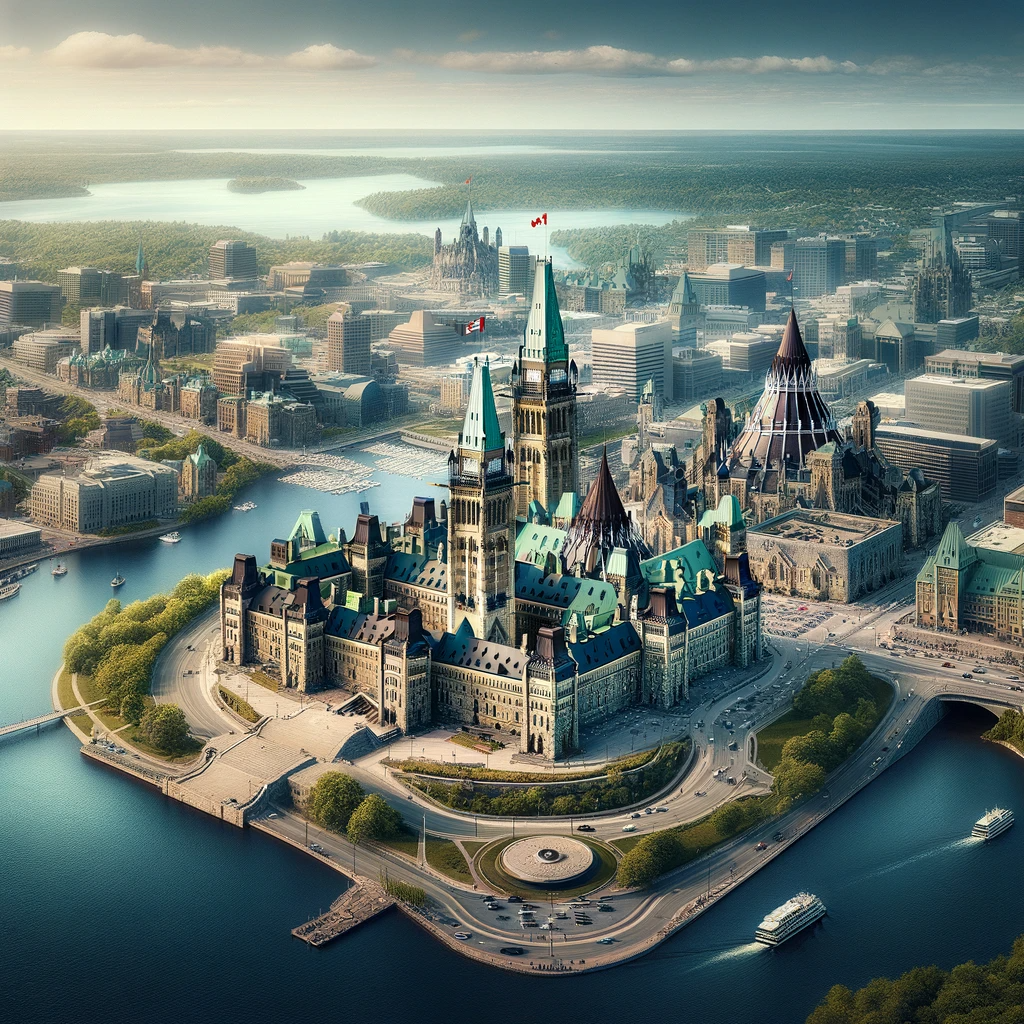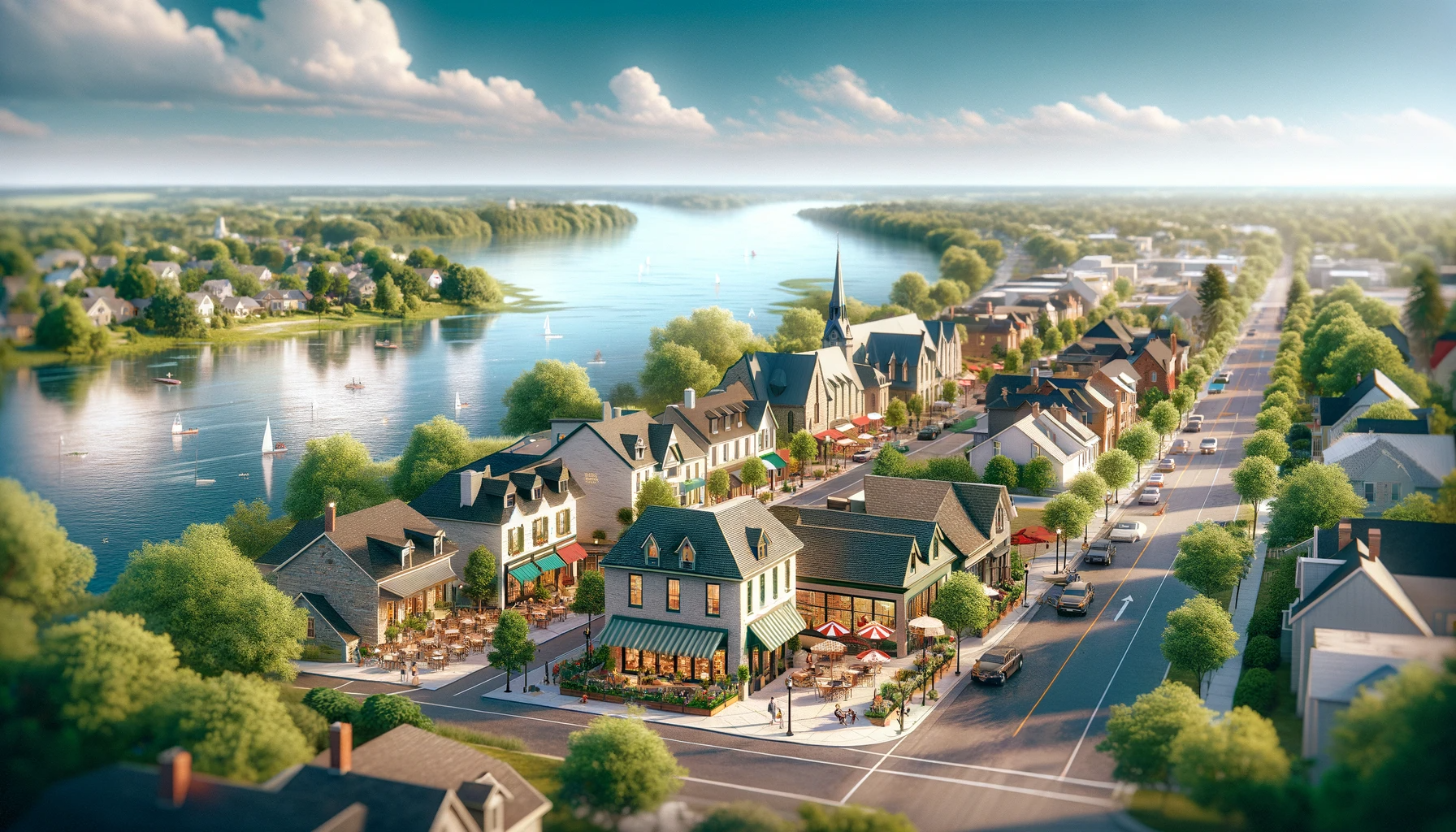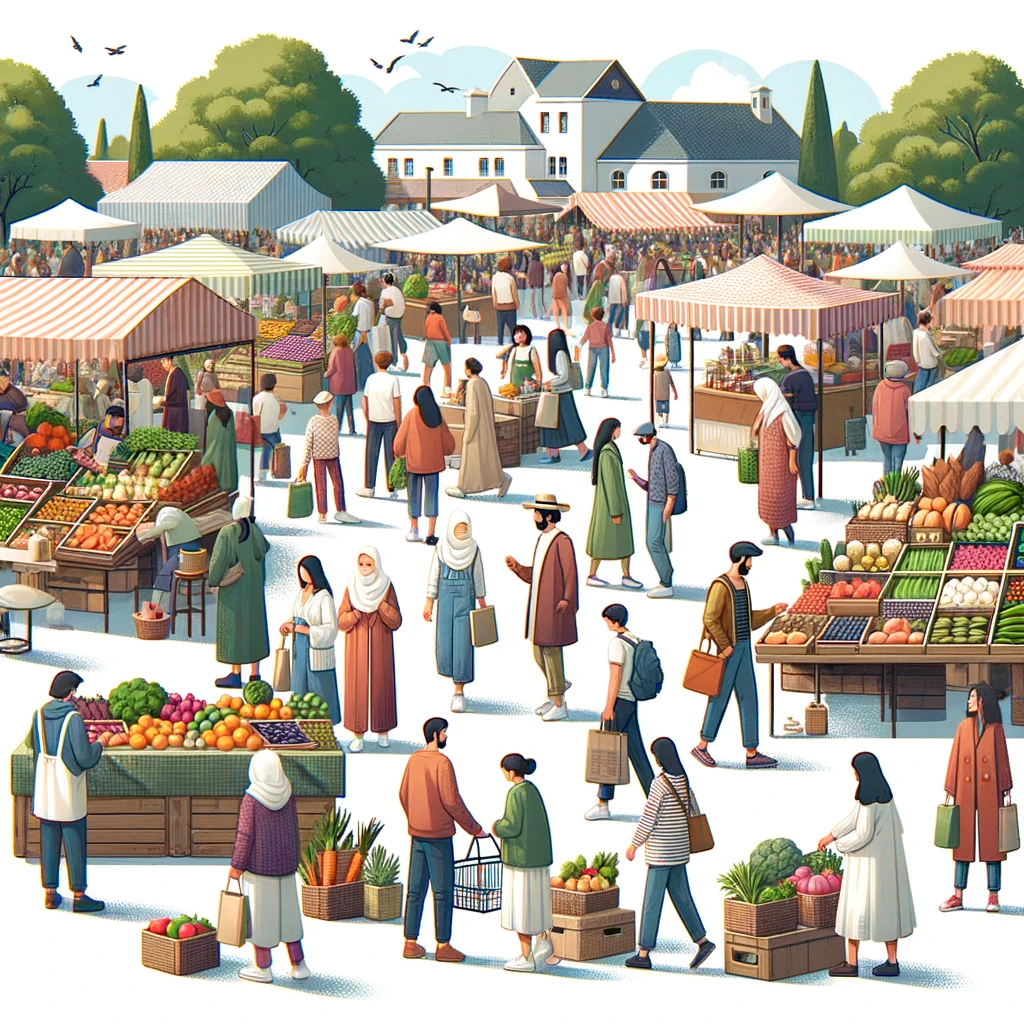Location of Canada's Capital: Where is Ottawa Located?
Ottawa: The Capital of Canada
Nestled in the heart of Canada's vast landscape lies Ottawa, a city rich in culture, history, and political significance. Known as the capital of Canada, Ottawa's location is not just a matter of geographical importance but also a symbol of the nation's historical journey and cultural diversity. This article aims to unravel the mystery of Ottawa's location, delving deep into its geographical coordinates, historical roots, and the vibrant life it offers today. From its picturesque position on the banks of the Ottawa River to its role as the administrative center of Canada, Ottawa presents a unique blend of natural beauty and urban sophistication. As we explore the question, "Where is Ottawa located?" we also embark on a journey to discover the essence of this remarkable city, understanding its place not only on the map but also in the heart of Canadian identity.

Ottawa, the capital city of Canada, is a beacon of culture, history, and political prowess. This illustrious city sits elegantly on the eastern side of the province of Ontario, at the confluence of three majestic rivers: the Ottawa, Gatineau, and Rideau. As the fourth largest city in Canada, Ottawa not only plays a pivotal role in the administration and governance of the nation but also serves as a symbol of Canada's rich historical tapestry and diverse cultural heritage.
Geographical Significance
Ottawa's geographic position is significant for several reasons. Firstly, its location along the Ottawa River was historically important for trade and transportation. This river, which marks the border between Ontario and Quebec, played a crucial role in the early exploration and development of Canada. Today, this location facilitates a unique blend of English and French Canadian cultures, making Ottawa a bilingual and bicultural city.
Secondly, Ottawa's proximity to the United States, particularly the state of New York, has been instrumental in its political and economic relationships. This strategic location has made Ottawa a focal point for international diplomacy and trade discussions.
Cultural and Political Hub
As the capital, Ottawa is home to Parliament Hill, the seat of Canada's federal government. This iconic set of buildings, perched on the southern banks of the Ottawa River, is not just a political landmark but also a symbol of Canadian democracy and resilience. The city also hosts numerous national museums, galleries, and cultural institutions, which collectively narrate the story of Canada's past and present.
Ottawa’s rich cultural scene is evident through its vibrant festivals, such as the Canadian Tulip Festival and Winterlude, which draw visitors from around the world. These events, along with the city's diverse culinary scene and lively entertainment options, reflect the city's multicultural ethos.
A City of Greenery and Innovation
Despite being the center of Canadian politics, Ottawa is known for its green spaces and parks, offering a serene escape from urban life. The Rideau Canal, a UNESCO World Heritage Site, is a centerpiece of the city, providing a unique recreational space for both locals and tourists. In winter, it transforms into the world’s largest skating rink, embodying the city's innovative spirit and community engagement.
Furthermore, Ottawa's economy is fueled by its high-tech industry, earning it the nickname "Silicon Valley North." This blend of nature, technology, and urban development makes Ottawa a city of the future, rooted in a rich historical past.

Ottawa's Geographic Location: Proximity to Major Cities and Natural Landmarks
Ottawa, the capital of Canada, is strategically situated in the eastern part of Ontario, serving as a gateway to both Ontario and Quebec provinces. This prime location offers a unique blend of urban convenience and natural beauty, making it a standout destination for both residents and visitors alike.
A Central Location in Canada's Landscape
Ottawa is located approximately 200 kilometers west of Montreal, one of Canada's largest and most vibrant cities. This proximity to Montreal allows for a rich exchange of culture, business, and tourism, strengthening Ottawa's role as a bilingual and multicultural city. Additionally, Ottawa is about a 4.5-hour drive from Toronto, Canada's largest city and economic hub. This closeness facilitates significant economic and cultural ties, contributing to Ottawa's prominence in national affairs.
Bordering the United States
Another aspect of Ottawa's geographic importance is its proximity to the United States. Located just 150 kilometers south of the Canada-U.S. border, Ottawa's location plays a crucial role in international relations and trade. This nearness to the U.S. has made the city an important center for diplomacy, hosting embassies and high commissions from around the world.
Surrounded by Natural Beauty
Ottawa's location also offers access to stunning natural landscapes. The Ottawa River, which forms the border between Ontario and Quebec, provides a picturesque backdrop for the city. This river is not only historically significant but also a hub for recreational activities like boating, fishing, and kayaking. To the north, the Gatineau Hills offer a scenic escape with their lush forests, wildlife, and outdoor activities, including hiking and skiing.
Gateway to the Great Canadian Wilderness
As a gateway to the vast Canadian wilderness, Ottawa is a starting point for exploring the greater Ontario and Quebec regions, known for their abundant natural parks and wildlife reserves. These areas offer endless opportunities for adventure and exploration, from the rugged landscapes of Algonquin Provincial Park to the serene beauty of the Thousand Islands.
A City Integrated with Nature
What sets Ottawa apart is how seamlessly nature is integrated into the city's fabric. Green spaces, parks, and pathways are abundant, offering residents and visitors a unique urban experience surrounded by natural beauty. The Rideau Canal, a prominent feature of the city, exemplifies this integration. It serves as a recreational area throughout the year, transforming into a skating rink in winter and a boating paradise in summer.
Ottawa's geographic location is not just a matter of coordinates; it reflects the city's character — a blend of urban sophistication and natural allure. This unique positioning makes Ottawa an intriguing and inviting capital city, deeply connected to both its Canadian roots and its global presence.
Historical Context: How Ottawa Became Canada's Capital
The story of how Ottawa became the capital of Canada is a fascinating tale of strategic choice, political compromise, and visionary planning. Understanding this history not only sheds light on Ottawa's current status but also reveals much about the formation of the Canadian nation itself.
Queen Victoria's Decision
The selection of Ottawa as the capital of Canada was a decision made by Queen Victoria in 1857. At the time, Canada was still a British colony, and the choice of a capital was contentious, with several cities vying for the honor. Ottawa, then a small logging town known as Bytown, was chosen for several strategic reasons. Its location away from the American border made it less vulnerable to attacks, a significant concern during a period of heightened tensions with the United States. Additionally, its position between English-speaking Ontario and French-speaking Quebec made it a symbol of the union between the two dominant cultural groups in Canada.
Transformation from Bytown to Ottawa
Following Queen Victoria's decision, Ottawa underwent a dramatic transformation. The construction of the Parliament Buildings began in the late 1850s, symbolizing the city's new status. These iconic structures, designed in a grand Gothic Revival style, were to house the legislative and administrative functions of the growing nation. The city's infrastructure, including roads, bridges, and public buildings, was rapidly developed to accommodate its new role.
Ottawa's Role in Canadian Federation
Ottawa's designation as the capital played a significant role in the Canadian Confederation of 1867. As the capital, Ottawa became the political and administrative center of the newly formed Dominion of Canada. The city's growth mirrored the development of the nation, with government departments, foreign embassies, and cultural institutions establishing themselves in Ottawa.
A Capital Through Wars and Beyond
Ottawa's importance was further cemented during the World Wars, where it served as a crucial center for war efforts and international diplomacy. Post-war, the city continued to grow, both in size and in global significance. It became the stage for significant political events, national celebrations, and international summits.
Preserving History and Embracing the Future
Today, Ottawa's rich history is visible in its well-preserved heritage buildings, historic sites, and museums. The city balances its historical roots with a forward-looking vision, continually evolving as a modern capital while honoring its past.
The journey of Ottawa from a humble logging town to the capital of Canada is a testament to the city's resilience and adaptability. It reflects the broader narrative of Canada's growth from a collection of colonies to a unified, independent nation.

Ottawa Today: A Modern City with Rich Cultural Heritage
Ottawa, as Canada's capital, stands today as a testament to its rich past and a beacon of its bright future. The city elegantly weaves its historical significance with modern dynamism, creating a unique urban tapestry that captivates both residents and visitors.
A Political and Administrative Center
At its core, Ottawa remains the political heart of Canada. Home to the Parliament of Canada, the Supreme Court, and numerous government departments, the city pulses with the lifeblood of Canadian governance. These institutions, set against the backdrop of the Ottawa River and historic architecture, create a dignified and majestic atmosphere.
Cultural Diversity and Inclusivity
Ottawa's cultural scene is as diverse as its population. The city celebrates its multiculturalism through festivals, museums, and culinary experiences. The ByWard Market, one of Canada's oldest and largest public markets, is a mosaic of international cuisines, artisan products, and vibrant nightlife. Cultural institutions like the National Gallery of Canada and the Canadian Museum of History offer immersive experiences into the arts, history, and identity of the nation.
Innovation and Technology
Ottawa is not just about politics and culture; it's also a hub for innovation and technology. Dubbed 'Silicon Valley North,' the city boasts a thriving tech industry, with numerous startups and established tech giants contributing to its economy. This blend of technology and tradition makes Ottawa a city that respects its past while boldly looking towards the future.
Green Spaces and Recreation
Despite its urban landscape, Ottawa is interspersed with lush parks and green spaces. The city values its natural surroundings, offering residents and visitors alike an abundance of outdoor activities. From cycling along the Rideau Canal to enjoying the peace of Gatineau Park, Ottawa provides a green escape within the city limits.
A City of Festivals and Events
Ottawa is a city that loves to celebrate. From the iconic Canada Day celebrations to the enchanting Winterlude festival, the city's calendar is packed with events that showcase its spirit and community. These festivals not only attract tourists but also strengthen the communal bond, making Ottawa a city with a warm and welcoming heart.
Ottawa today is a multifaceted city. It's a place where history meets innovation, where nature blends with urbanity, and where cultures from around the world come together. This unique mix makes Ottawa not just a capital city in name, but in spirit and experience.

Visiting Ottawa: Key Attractions and Travel Tips
Ottawa, a city that seamlessly blends historical charm with modern vibrancy, is a must-visit destination for travelers. Whether you're interested in exploring Canada's political heritage, indulging in cultural experiences, or enjoying outdoor activities, Ottawa has something for everyone.
Iconic Landmarks and Historical Sites
A visit to Ottawa is incomplete without exploring its iconic landmarks. The Parliament Hill, with its stunning Gothic Revival architecture, offers guided tours and a chance to witness the changing of the guard. Nearby, the National War Memorial and the Canadian Tomb of the Unknown Soldier are solemn reminders of the nation's history and sacrifices.
Cultural and Artistic Exploration
For art and culture enthusiasts, Ottawa's galleries and museums are treasure troves. The National Gallery of Canada houses an impressive collection of Canadian and Indigenous art, while the Canadian Museum of History offers insights into the country's rich heritage. The ByWard Market is not just a shopping destination but also a cultural hub, with its diverse range of restaurants, cafes, and local artisan shops.
Outdoor Adventures and Natural Beauty
Nature lovers will find plenty to explore in and around Ottawa. The Rideau Canal, a UNESCO World Heritage Site, is perfect for a leisurely boat ride in summer or ice skating in winter. Gatineau Park, with its trails and scenic lookouts, is ideal for hiking, biking, and picnicking. In autumn, the park is a popular spot for leaf-peeping, with its stunning display of fall foliage.
Festivals and Events
Ottawa's calendar is filled with festivals and events throughout the year. The Canadian Tulip Festival in spring showcases over a million tulips in bloom, while Winterlude in February transforms the city into a winter wonderland with ice sculptures and snowy activities. These events not only highlight Ottawa's cultural diversity but also its community spirit.
Travel Tips for Visitors
When planning a trip to Ottawa, consider visiting during the shoulder seasons of spring or fall for milder weather and fewer crowds. The city is well-connected by public transportation, making it easy to navigate. Additionally, many of Ottawa's attractions are within walking distance of each other, especially in the downtown area. For a unique experience, try exploring the city on a bike or taking a boat tour along the Ottawa River.
As Canada's capital, Ottawa offers a rich tapestry of experiences, from historical insights to modern attractions, set against a backdrop of natural beauty. This city, with its welcoming atmosphere and diverse offerings, promises an unforgettable visit.

In exploring the question, "Where is Ottawa located?" we've journeyed far beyond its geographical coordinates. Ottawa, as Canada's capital, is a city that embodies the heart and soul of the nation. From its strategic selection by Queen Victoria to its evolution into a vibrant, modern city, Ottawa has played a pivotal role in shaping Canadian identity.
The city's unique blend of history, culture, and natural beauty makes it a microcosm of Canada itself. Ottawa's political significance, coupled with its cultural diversity and innovative spirit, creates an atmosphere that is both dignified and dynamic. Its green spaces and commitment to preserving the natural environment showcase a city that values its past while embracing the future.
Visitors to Ottawa can experience a tapestry of experiences that reflect the nation's heritage and aspirations. Whether it's exploring historic sites, indulging in cultural festivals, or enjoying the great outdoors, Ottawa offers a rich and diverse palette for exploration and discovery.
In conclusion, Ottawa is more than just the answer to the question of its location. It is a living, breathing representation of Canada's past, present, and future — a city where history is honored, diversity is celebrated, and innovation is embraced. Ottawa stands not just on the map of Canada, but at the forefront of what it means to be Canadian.
Ottawa: The Capital of Canada
Nestled in the heart of Canada's vast landscape lies Ottawa, a city rich in culture, history, and political significance. Known as the capital of Canada, Ottawa's location is not just a matter of geographical importance but also a symbol of the nation's historical journey and cultural diversity. This article aims to unravel the mystery of Ottawa's location, delving deep into its geographical coordinates, historical roots, and the vibrant life it offers today. From its picturesque position on the banks of the Ottawa River to its role as the administrative center of Canada, Ottawa presents a unique blend of natural beauty and urban sophistication. As we explore the question, "Where is Ottawa located?" we also embark on a journey to discover the essence of this remarkable city, understanding its place not only on the map but also in the heart of Canadian identity.
Ottawa, the capital city of Canada, is a beacon of culture, history, and political prowess. This illustrious city sits elegantly on the eastern side of the province of Ontario, at the confluence of three majestic rivers: the Ottawa, Gatineau, and Rideau. As the fourth largest city in Canada, Ottawa not only plays a pivotal role in the administration and governance of the nation but also serves as a symbol of Canada's rich historical tapestry and diverse cultural heritage.
Geographical Significance
Ottawa's geographic position is significant for several reasons. Firstly, its location along the Ottawa River was historically important for trade and transportation. This river, which marks the border between Ontario and Quebec, played a crucial role in the early exploration and development of Canada. Today, this location facilitates a unique blend of English and French Canadian cultures, making Ottawa a bilingual and bicultural city.
Secondly, Ottawa's proximity to the United States, particularly the state of New York, has been instrumental in its political and economic relationships. This strategic location has made Ottawa a focal point for international diplomacy and trade discussions.
Cultural and Political Hub
As the capital, Ottawa is home to Parliament Hill, the seat of Canada's federal government. This iconic set of buildings, perched on the southern banks of the Ottawa River, is not just a political landmark but also a symbol of Canadian democracy and resilience. The city also hosts numerous national museums, galleries, and cultural institutions, which collectively narrate the story of Canada's past and present.
Ottawa’s rich cultural scene is evident through its vibrant festivals, such as the Canadian Tulip Festival and Winterlude, which draw visitors from around the world. These events, along with the city's diverse culinary scene and lively entertainment options, reflect the city's multicultural ethos.
Canadian Tulip Festival and Winterlude, which draw visitors from around the world. These events, along with the city's diverse culinary scene and lively entertainment options, reflect the city's multicultural ethos.
A City of Greenery and Innovation
Despite being the center of Canadian politics, Ottawa is known for its green spaces and parks, offering a serene escape from urban life. The Rideau Canal, a UNESCO World Heritage Site, is a centerpiece of the city, providing a unique recreational space for both locals and tourists. In winter, it transforms into the world’s largest skating rink, embodying the city's innovative spirit and community engagement.
Furthermore, Ottawa's economy is fueled by its high-tech industry, earning it the nickname "Silicon Valley North." This blend of nature, technology, and urban development makes Ottawa a city of the future, rooted in a rich historical past.
Ottawa's Geographic Location: Proximity to Major Cities and Natural Landmarks
Ottawa, the capital of Canada, is strategically situated in the eastern part of Ontario, serving as a gateway to both Ontario and Quebec provinces. This prime location offers a unique blend of urban convenience and natural beauty, making it a standout destination for both residents and visitors alike.

A Central Location in Canada's Landscape
Ottawa is located approximately 200 kilometers west of Montreal, one of Canada's largest and most vibrant cities. This proximity to Montreal allows for a rich exchange of culture, business, and tourism, strengthening Ottawa's role as a bilingual and multicultural city. Additionally, Ottawa is about a 4.5-hour drive from Toronto, Canada's largest city and economic hub. This closeness facilitates significant economic and cultural ties, contributing to Ottawa's prominence in national affairs.
Bordering the United States
Another aspect of Ottawa's geographic importance is its proximity to the United States. Located just 150 kilometers south of the Canada-U.S. border, Ottawa's location plays a crucial role in international relations and trade. This nearness to the U.S. has made the city an important center for diplomacy, hosting embassies and high commissions from around the world.
Surrounded by Natural Beauty
Ottawa's location also offers access to stunning natural landscapes. The Ottawa River, which forms the border between Ontario and Quebec, provides a picturesque backdrop for the city. This river is not only historically significant but also a hub for recreational activities like boating, fishing, and kayaking. To the north, the Gatineau Hills offer a scenic escape with their lush forests, wildlife, and outdoor activities, including hiking and skiing.
Gateway to the Great Canadian Wilderness
As a gateway to the vast Canadian wilderness, Ottawa is a starting point for exploring the greater Ontario and Quebec regions, known for their abundant natural parks and wildlife reserves. These areas offer endless opportunities for adventure and exploration, from the rugged landscapes of Algonquin Provincial Park to the serene beauty of the Thousand Islands.
A City Integrated with Nature
What sets Ottawa apart is how seamlessly nature is integrated into the city's fabric. Green spaces, parks, and pathways are abundant, offering residents and visitors a unique urban experience surrounded by natural beauty. The Rideau Canal, a prominent feature of the city, exemplifies this integration. It serves as a recreational area throughout the year, transforming into a skating rink in winter and a boating paradise in summer.
Ottawa's geographic location is not just a matter of coordinates; it reflects the city's character — a blend of urban sophistication and natural allure. This unique positioning makes Ottawa an intriguing and inviting capital city, deeply connected to both its Canadian roots and its global presence.

Historical Context: How Ottawa Became Canada's Capital
The story of how Ottawa became the capital of Canada is a fascinating tale of strategic choice, political compromise, and visionary planning. Understanding this history not only sheds light on Ottawa's current status but also reveals much about the formation of the Canadian nation itself.
Queen Victoria's Decision
The selection of Ottawa as the capital of Canada was a decision made by Queen Victoria in 1857. At the time, Canada was still a British colony, and the choice of a capital was contentious, with several cities vying for the honor. Ottawa, then a small logging town known as Bytown, was chosen for several strategic reasons. Its location away from the American border made it less vulnerable to attacks, a significant concern during a period of heightened tensions with the United States. Additionally, its position between English-speaking Ontario and French-speaking Quebec made it a symbol of the union between the two dominant cultural groups in Canada.
Transformation from Bytown to Ottawa
Following Queen Victoria's decision, Ottawa underwent a dramatic transformation. The construction of the Parliament Buildings began in the late 1850s, symbolizing the city's new status. These iconic structures, designed in a grand Gothic Revival style, were to house the legislative and administrative functions of the growing nation. The city's infrastructure, including roads, bridges, and public buildings, was rapidly developed to accommodate its new role.
Ottawa's Role in Canadian Federation
Ottawa's designation as the capital played a significant role in the Canadian Confederation of 1867. As the capital, Ottawa became the political and administrative center of the newly formed Dominion of Canada. The city's growth mirrored the development of the nation, with government departments, foreign embassies, and cultural institutions establishing themselves in Ottawa.
A Capital Through Wars and Beyond
Ottawa's importance was further cemented during the World Wars, where it served as a crucial center for war efforts and international diplomacy. Post-war, the city continued to grow, both in size and in global significance. It became the stage for significant political events, national celebrations, and international summits.
Preserving History and Embracing the Future
Today, Ottawa's rich history is visible in its well-preserved heritage buildings, historic sites, and museums. The city balances its historical roots with a forward-looking vision, continually evolving as a modern capital while honoring its past.
The journey of Ottawa from a humble logging town to the capital of Canada is a testament to the city's resilience and adaptability. It reflects the broader narrative of Canada's growth from a collection of colonies to a unified, independent nation.
Ottawa Today: A Modern City with Rich Cultural Heritage
Ottawa, as Canada's capital, stands today as a testament to its rich past and a beacon of its bright future. The city elegantly weaves its historical significance with modern dynamism, creating a unique urban tapestry that captivates both residents and visitors.
A Political and Administrative Center
At its core, Ottawa remains the political heart of Canada. Home to the Parliament of Canada, the Supreme Court, and numerous government departments, the city pulses with the lifeblood of Canadian governance. These institutions, set against the backdrop of the Ottawa River and historic architecture, create a dignified and majestic atmosphere.

Cultural Diversity and Inclusivity
Ottawa's cultural scene is as diverse as its population. The city celebrates its multiculturalism through festivals, museums, and culinary experiences. The ByWard Market, one of Canada's oldest and largest public markets, is a mosaic of international cuisines, artisan products, and vibrant nightlife. Cultural institutions like the National Gallery of Canada and the Canadian Museum of History offer immersive experiences into the arts, history, and identity of the nation.
Innovation and Technology
Ottawa is not just about politics and culture; it's also a hub for innovation and technology. Dubbed 'Silicon Valley North,' the city boasts a thriving tech industry, with numerous startups and established tech giants contributing to its economy. This blend of technology and tradition makes Ottawa a city that respects its past while boldly looking towards the future.
Green Spaces and Recreation
Despite its urban landscape, Ottawa is interspersed with lush parks and green spaces. The city values its natural surroundings, offering residents and visitors alike an abundance of outdoor activities. From cycling along the Rideau Canal to enjoying the peace of Gatineau Park, Ottawa provides a green escape within the city limits.
A City of Festivals and Events
Ottawa is a city that loves to celebrate. From the iconic Canada Day celebrations to the enchanting Winterlude festival, the city's calendar is packed with events that showcase its spirit and community. These festivals not only attract tourists but also strengthen the communal bond, making Ottawa a city with a warm and welcoming heart.
Ottawa today is a multifaceted city. It's a place where history meets innovation, where nature blends with urbanity, and where cultures from around the world come together. This unique mix makes Ottawa not just a capital
Visiting Ottawa: Key Attractions and Travel Tips
Ottawa, a city that seamlessly blends historical charm with modern vibrancy, is a must-visit destination for travelers. Whether you're interested in exploring Canada's political heritage, indulging in cultural experiences, or enjoying outdoor activities, Ottawa has something for everyone.
Iconic Landmarks and Historical Sites
A visit to Ottawa is incomplete without exploring its iconic landmarks. The Parliament Hill, with its stunning Gothic Revival architecture, offers guided tours and a chance to witness the changing of the guard. Nearby, the National War Memorial and the Canadian Tomb of the Unknown Soldier are solemn reminders of the nation's history and sacrifices.
Cultural and Artistic Exploration
For art and culture enthusiasts, Ottawa's galleries and museums are treasure troves. The National Gallery of Canada houses an impressive collection of Canadian and Indigenous art, while the Canadian Museum of History offers insights into the country's rich heritage. The ByWard Market is not just a shopping destination but also a cultural hub, with its diverse range of restaurants, cafes, and local artisan shops.

Outdoor Adventures and Natural Beauty
Nature lovers will find plenty to explore in and around Ottawa. The Rideau Canal, a UNESCO World Heritage Site, is perfect for a leisurely boat ride in summer or ice skating in winter. Gatineau Park, with its trails and scenic lookouts, is ideal for hiking, biking, and picnicking. In autumn, the park is a popular spot for leaf-peeping, with its stunning display of fall foliage.
Festivals and Events
Ottawa's calendar is filled with festivals and events throughout the year. The Canadian Tulip Festival in spring showcases over a million tulips in bloom, while Winterlude in February transforms the city into a winter wonderland with ice sculptures and snowy activities. These events not only highlight Ottawa's cultural diversity but also its community spirit.
Travel Tips for Visitors
When planning a trip to Ottawa, consider visiting during the shoulder seasons of spring or fall for milder weather and fewer crowds. The city is well-connected by public transportation, making it easy to navigate. Additionally, many of Ottawa's attractions are within walking distance of each other, especially in the downtown area. For a unique experience, try exploring the city on a bike or taking a boat tour along the Ottawa River.
As Canada's capital, Ottawa offers a rich tapestry of experiences, from historical insights to modern attractions, set against a backdrop of natural beauty. This city, with its welcoming atmosphere and diverse offerings, promises an unforgettable visit.
In exploring the question, "Where is Ottawa located?" we've journeyed far beyond its geographical coordinates. Ottawa, as Canada's capital, is a city that embodies the heart and soul of the nation. From its strategic selection by Queen Victoria to its evolution into a vibrant, modern city, Ottawa has played a pivotal role in shaping Canadian identity.
The city's unique blend of history, culture, and natural beauty makes it a microcosm of Canada itself. Ottawa's political significance, coupled with its cultural diversity and innovative spirit, creates an atmosphere that is both dignified and dynamic. Its green spaces and commitment to preserving the natural environment showcase a city that values its past while embracing the future.
Visitors to Ottawa can experience a tapestry of experiences that reflect the nation's heritage and aspirations. Whether it's exploring historic sites, indulging in cultural festivals, or enjoying the great outdoors, Ottawa offers a rich and diverse palette for exploration and discovery.
In conclusion, Ottawa is more than just the answer to the question of its location. It is a living, breathing representation of Canada's past, present, and future — a city where history is honored, diversity is celebrated, and innovation is embraced. Ottawa stands not just on the map of Canada, but at the forefront of what it means to be Canadian.
Moving to or from Ottawa? Contact Roch St-Georges to discuss your real estate needs.





